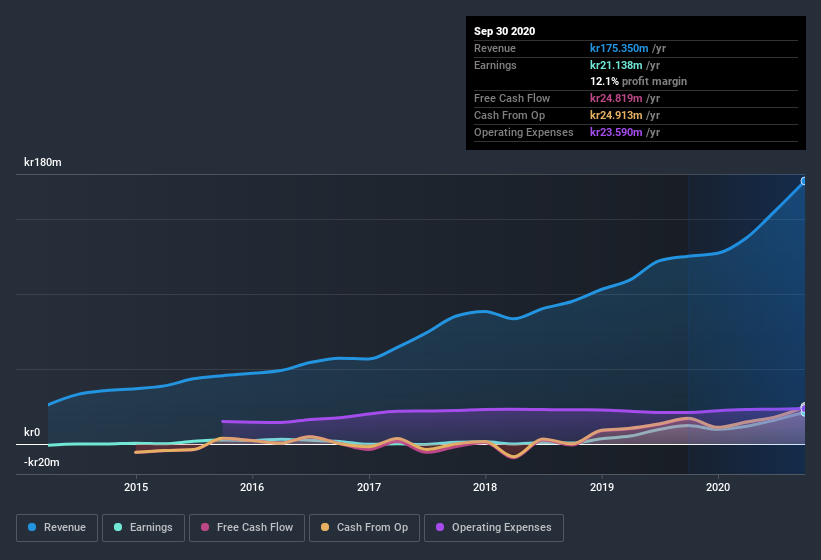Is There More To The Story Than Gullberg & Jansson's (NGM:GJAB) Earnings Growth?
It might be old fashioned, but we really like to invest in companies that make a profit, each and every year. Having said that, sometimes statutory profit levels are not a good guide to ongoing profitability, because some short term one-off factor has impacted profit levels. This article will consider whether Gullberg & Jansson's (NGM:GJAB) statutory profits are a good guide to its underlying earnings.
We like the fact that Gullberg & Jansson made a profit of kr21.1m on its revenue of kr175.3m, in the last year. In the chart below, you can see that its profit and revenue have both grown over the last three years.
See our latest analysis for Gullberg & Jansson

Importantly, statutory profits are not always the best tool for understanding a company's true earnings power, so it's well worth examining profits in a little more detail. So today we'll look at what Gullberg & Jansson's cashflow tells us about the quality of its earnings. Note: we always recommend investors check balance sheet strength. Click here to be taken to our balance sheet analysis of Gullberg & Jansson.
A Closer Look At Gullberg & Jansson's Earnings
As finance nerds would already know, the accrual ratio from cashflow is a key measure for assessing how well a company's free cash flow (FCF) matches its profit. In plain english, this ratio subtracts FCF from net profit, and divides that number by the company's average operating assets over that period. This ratio tells us how much of a company's profit is not backed by free cashflow.
Therefore, it's actually considered a good thing when a company has a negative accrual ratio, but a bad thing if its accrual ratio is positive. While having an accrual ratio above zero is of little concern, we do think it's worth noting when a company has a relatively high accrual ratio. Notably, there is some academic evidence that suggests that a high accrual ratio is a bad sign for near-term profits, generally speaking.
Gullberg & Jansson has an accrual ratio of -0.20 for the year to September 2020. Therefore, its statutory earnings were very significantly less than its free cashflow. In fact, it had free cash flow of kr25m in the last year, which was a lot more than its statutory profit of kr21.1m. Gullberg & Jansson's free cash flow improved over the last year, which is generally good to see.
Our Take On Gullberg & Jansson's Profit Performance
As we discussed above, Gullberg & Jansson's accrual ratio indicates strong conversion of profit to free cash flow, which is a positive for the company. Based on this observation, we consider it possible that Gullberg & Jansson's statutory profit actually understates its earnings potential! And on top of that, its earnings per share have grown at an extremely impressive rate over the last three years. Of course, we've only just scratched the surface when it comes to analysing its earnings; one could also consider margins, forecast growth, and return on investment, among other factors. If you want to do dive deeper into Gullberg & Jansson, you'd also look into what risks it is currently facing. You'd be interested to know, that we found 2 warning signs for Gullberg & Jansson and you'll want to know about these.
This note has only looked at a single factor that sheds light on the nature of Gullberg & Jansson's profit. But there are plenty of other ways to inform your opinion of a company. Some people consider a high return on equity to be a good sign of a quality business. So you may wish to see this free collection of companies boasting high return on equity, or this list of stocks that insiders are buying.
If you’re looking to trade Gullberg & Jansson, open an account with the lowest-cost* platform trusted by professionals, Interactive Brokers. Their clients from over 200 countries and territories trade stocks, options, futures, forex, bonds and funds worldwide from a single integrated account. Promoted
New: Manage All Your Stock Portfolios in One Place
We've created the ultimate portfolio companion for stock investors, and it's free.
• Connect an unlimited number of Portfolios and see your total in one currency
• Be alerted to new Warning Signs or Risks via email or mobile
• Track the Fair Value of your stocks
This article by Simply Wall St is general in nature. It does not constitute a recommendation to buy or sell any stock, and does not take account of your objectives, or your financial situation. We aim to bring you long-term focused analysis driven by fundamental data. Note that our analysis may not factor in the latest price-sensitive company announcements or qualitative material. Simply Wall St has no position in any stocks mentioned.
*Interactive Brokers Rated Lowest Cost Broker by StockBrokers.com Annual Online Review 2020
Have feedback on this article? Concerned about the content? Get in touch with us directly. Alternatively, email editorial-team (at) simplywallst.com.
About NGM:GJAB
Gullberg & Jansson
Develops, produces, and markets products for use in the green space, swimming pool, and relaxation and wellness industries in the Nordic markets.
Adequate balance sheet low.
Market Insights
Community Narratives



